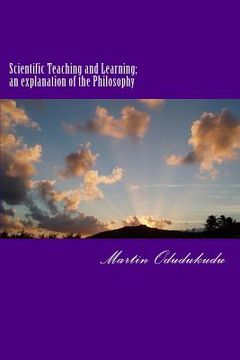Reseña del libro "Scientific Teaching and Learning; an explanation of the Philosophy (en Inglés)"
SCIENTIFIC TEACHING AND LEARNING This book has the same focus as the common core learning standard; it is intended to meet the aspirations of the employer, parents, educators and students. Our focus is very promising. Our educational efforts are now geared to change from focusing upon teaching students to pass tests to learning how to apply knowledge. We now know that a capacity to merely recall answers relates to the old traditional methods of teaching and learning and that the capacity to think through problems and get answers relate to the progressive methods. We are also realizing that success in our educational efforts are grounded upon a clear understanding of students interest, and of how to integrating students' concerns with the subject matter; but do we truly? THE SCIENTIFIC TEACHING The common core learning standard helps to bring to focus the realization that children can learn at higher levels when properly taught to do so. No age group or grade level corresponds with and/or is restricted to a particular level of learning. The first and second grade students can do simple equation if their teachers can teach them how to do it. Human beings can and do achieve increased capacity to simplify, understand and address problems; they think. What is not so clear in regard to the common core, however, is what human beings do when they think. The authors of the common core learning standard seem to have simply pointed at what students can do, at human capacities, and told others to go figure it out harness these capacities. With "Scientific Teaching; an explanation of the Philosophy," we find that in thinking, one is concerned with the subject and predicate (aspects) relationships of a subject matter. In the subject (premise, context, and ground) aspect of a concern or subject matter, one generates and/or analyzes the constituting elements; but in the predicate (conclusion, occurrence) aspect of a representation one obtains a synthesized representation. However, authors of the common core learning standard do not emphasize these aspect of learning; they say that the local education agencies are responsible for this aspect of the common core. This leaves the local agencies with little or no clear methods to harness resources and to achieve a goal they did not set. In the Scientific Teaching, we explain the philosophies and present the instructional methods of Goal and Task Teaching and Learning. GTTL is said to be scientific in that the methods have a shared focus; the focus is the same for Mathematics, Physics, Chemistry or Biology as it is for the English Language Arts. This book is divided into four main sections: In section (1) we categorize teachers into four groups (advocates of efforts and autonomy, and affected and disaffected eclectics) in accordance to the beliefs they hold. Section (2) attempts to explicate a theory of interest; here we differentiate interest that are due to external from those that are due to internal occurrences. We explain how an actual task situation and/or object affect a student's interest. Section (3) explicates the scientific aspects of a subject matter; here, we explicate the subject and predicate aspects of a subject matter. This section is presented with many illustrations and examples, and is simplified for the most reluctant readers. And, in section (4) we further clarify the Goal and Task Teaching and Learning (GTTL) method, a teaching method for which we hold a patent. In this last section, we explain how thinking and interest are connected; and how scientific teaching relates to thinking and interest.

